I remember Wright-Patt for other reasons, though. My father worked there after we returned from Germany in 1991, so I recall going along to the base exchange, the commissary, and, of course, the tiny arcade.
Wright Patt’s arcade was barely even a room. It was more of an alcove with a dozen cabinets inside, situated near the vending machines. I’d go as often as I could, regularly sacrificing Saturday morning cartoons so I could tag along with my father. While he shopped, I’d spend an hour or two in this little gallery of arcade games.
Solitude was part of the appeal. In the early hours of most Saturday mornings I was the only one at the arcade. There was no one around to hog Super Baseball 2020 or beat me at Fighters History Dynamite, no one to make too much noise over a game of Raiden, and, most importantly, no one to recognize me from school and therefore remind me how miserable I was during the rest of the week. Wright-Patt’s arcade wasn’t the biggest or best that I’d ever visited, but for an hour or two each week it was the only one that was all mine.
A lot of arcade games came through Wright-Patt’s little nook, but I’ll narrow it down to three that I remember vividly and haven’t yet discussed too much here.
CADASH
I always went for RPGs as a kid, whether it was the latest Final Fantasy or some lesser curiosity like Dragon View. It was a matter of economics. I bought only two or three full-priced games a year, and an RPG was all but guaranteed to last me three months. Even if it was a bland three months of Traysia or Breath of Fire, that was a surer bet than even the finest action game or fighter on the market. Perhaps it was often a case of picking the Golden Corral buffet over a five-star restaurant, but I wanted my money’s worth.
I also liked the pace of RPGs. I could explore. I could take my time. I could wander a village where half the residents said the same thing, or spend hours fighting monsters in the hills. RPGs offered a lot of freedom, and I rarely saw the same thing in arcade games.
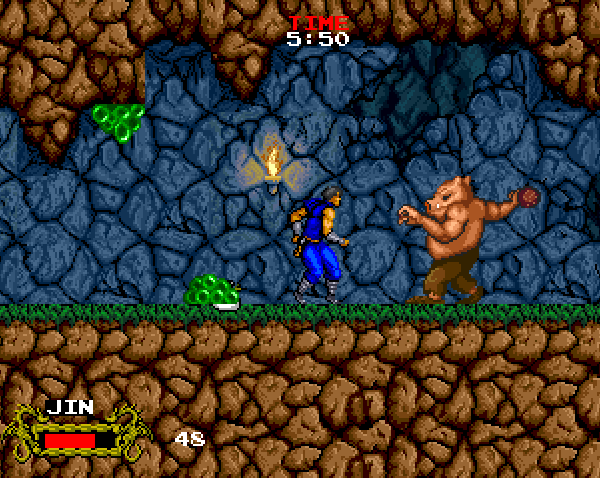
That’s why I liked Cadash so much. It’s a side-scroller with cheap demises and a time limit, but it’s trimmed with RPG devices, from the pacing townsfolk and their awkwardly translated hints to the weapon shops and minor plot threads. The Wright-Patt arcade had only one Cadash machine, so I never saw the game in its LAN-linked four-player glory, but I always liked seeing how far I could get on a few quarters. At most, I could make it past the second boss and learn that a village girl marked for sacrifice was really a mermaid—a technically topless mermaid, the likes of which my at-home RPGs could never dare depict.
So Cadash was my go-to for many Wright-Patt arcade mornings. I liked all of the four playable characters, but I most often picked the Priest—or rather, the Priestess—just to mess with every villager who greeted the player as “BRAVE MAN.” It felt like I was outsmarting the game, or at least turning the king into being a subtly sexist jerk. Yeah, he’s been waiting for a brave man to arrive, but he figures he has to take what he can get.
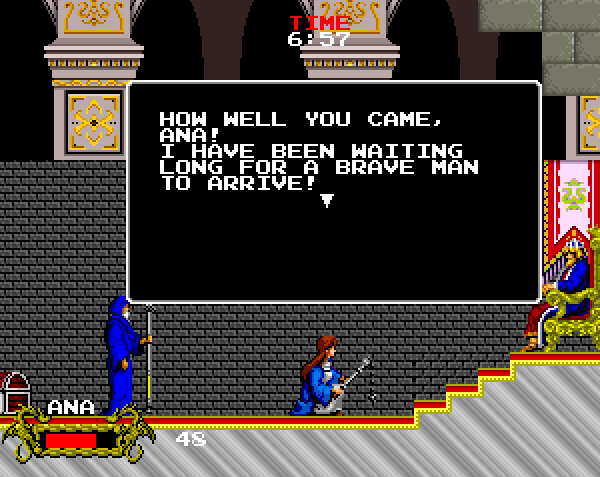
It’s strange that I never got into the home versions of Cadash. The Genesis port removed the two best characters (that’d be the priest and the ninja), and the much better TurboGrafx-16 version slipped my notice until it was madly expensive. I had other RPGs to play at home, after all, and while Cadash clearly had substance, I couldn’t be sure it would occupy me all the way to Christmas or my birthday. For the arcade, though, it was perfect. It was nice enough to kill me slowly.
KNUCKLE HEADS
I’m still fascinated by the early contenders of the fighting game craze. Capcom’s Street Fighter II had just taken off in 1991, and every other company scrambled to improve on it, often in ways that didn’t matter. Konami tried making the on-screen characters bigger and therefore more awkward with Martial Champion. Allumer gave its warriors armor with the tellingly named Blandia. And Namco had a few ill-fated ideas with Knuckle Heads.
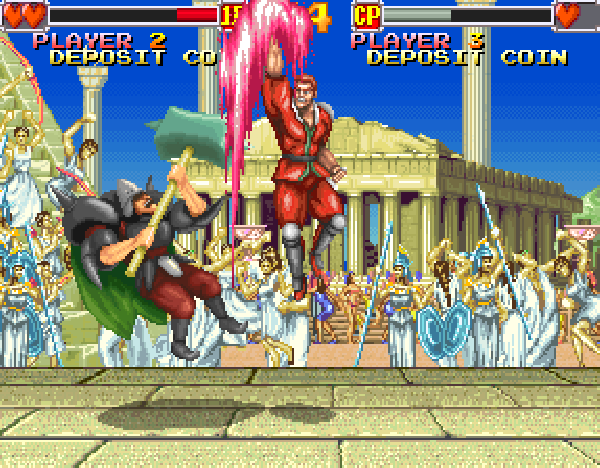
What set Knuckle Heads apart? It let four players fight at once, and it added a jump button to its two basic attacks. Beyond this, however, Knuckle Heads felt strangely anemic even back in 1992 and feels even more lacking today. It has only six characters, two less than Street Fighter II, and it doesn’t even hide a boss at its climax; you’ll just face a gold version of your chosen combatant. My fascination with Knuckle Heads lasted no longer than a weekend or two. The gameplay was clumsy and inscrutable to me, and at best I figured out that I could repeatedly throw my opponent for a few matches before the computer wised up.
As with most mediocre fighting games of the day, the only Knuckle Heads character that I bothered picking more than once was the standard-issue sparingly dressed female fighter. Her name is Claudia Silva, she wears a highly selective mixture of bikini and body armor, and her victory quote sounds for all the world like “Eat my heart!” It amused me to learn, years later, that Namco hired veteran voice actor Kotono Mitsuishi, who’s played everything from Sailor Moon to Evangelion’s Misato Katsuragi, to deliver that line.

That is not why I remember Knuckle Heads, however. A month or so after I’d lost interest in the game, I saw an older teenage boy and girl wander into the arcade. The boy played Knuckle Heads as the girl watched, and while I didn’t see which character he used, what happened next led me to suspect it was Claudia.
The boy finished playing, and as the two of them walked away from Knuckle Heads the girl asked him a question loud enough for me to hear five machines down.
“WELL,” she said, “DOES SHE LOOK LIKE YOUR MOTHER?”
He laughed. She laughed. I laughed as well. I didn’t know entirely why, but I was grateful that I was playing Cadash at a moment that didn’t involve naked mermaids.
They departed, and I was lost in thought. It would be ten minutes before I vaguely realized what she had meant and about ten years before I really pondered the Freudian breast fixations so common in video games and every other form of media. Yet my eyes were opened a little that morning, and that’s why I’ll never forget Knuckle Heads.
ZED BLADE
The Wright-Patt arcade was my introduction to the Neo Geo, SNK’s arcade hardware perfectly replicated in a console that cost more than certain small cars of the 1990s. With no way of affording the home system, I was glad that Wright-Patt’s arcade stocked half a dozen big red Neo Geo machines with new titles every month, starting with King of the Monsters and lasting all the way to Metal Slug X. Even today I have the strangest nostalgia for those rare moments when every Neo Geo machine reached its startup screen at the same time and the entire arcade echoed with bing-bong-bing-bing.
I visited Wright-Patt less and less as I got older, and the arcade shrank. The base exchange actually turned it into a room instead of a cubbyhole, but the game selection dried up. I would go there mostly to check out the latest Metal Slug and see if I spied anything I couldn’t find at other arcades—the ones I could visit without having to show my Air Force dependent ID.
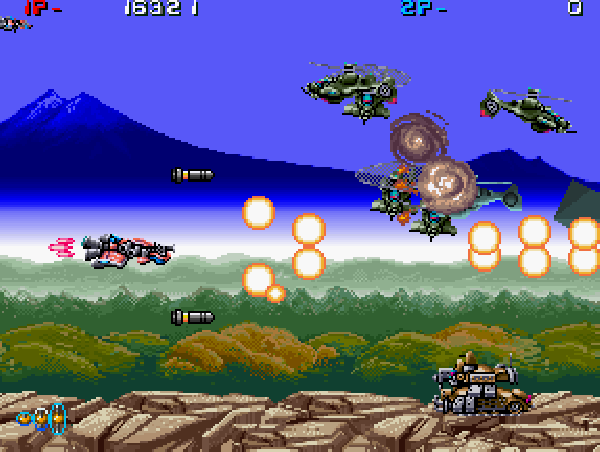
One day I saw NMK's Zed Blade. I knew nothing about it, but it was a Neo Geo shooter, and I was up for it. It’s not a striking game in any historical sense, but some little touches drew my eye. I liked how the levels scrolled slowly even when the enemies arrived thick and fast, I liked how your ship started with a decent selection of weapons instead of a pathetic Gradius plinker, and I liked how a lot of the mechanical creatures, including your own fighter, had a ramshackle design. It was as though they were kit-bashed from mecha models or actual military robots with decades of ugly modifications to keep them running.
As shooters go, Zed Blade wasn’t the champion of its day or even the third or fourth best on the Neo Geo, but it gave me that essential bullet-dodging rush and something fun to watch.
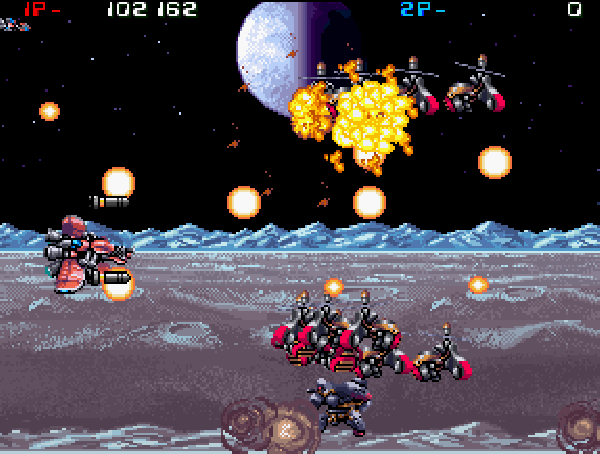
Zed Blade was gone the next time I stopped by the arcade, and I wouldn’t see it anywhere else. Its life on the Neo Geo was so brief that SNK never released it for either the expensive Neo Geo AES cartridge home console or the cheaper CD system. Zed Blade was a blip on the radar.
And that made it memorable. Before the days of emulators, arcade games were limited engagements. If a cabinet didn’t digest enough quarters, the arcade would soon swap it out for yet another Street Fighter or Mortal Kombat machine—as I learned when BloodStorm vanished from every arcade in a few months.
I took in everything about Zed Blade because I suspected I might never see it again. I also started to suspect that the Wright-Patt arcade itself might go the same way. Arcades were changing by the late 1990s, as the fighting-game craze dwindled and nothing rose to take its place. One day there was a jewelry shop where the Wright-Patt arcade had been.
In the end, an arcade was even more acutely ephemeral than the games it held. Zed Blade and Knuckle Heads and a thousand other obscurities are just an emulator click away these days. Yet there’s no going back to a quiet morning in 1993 when it was just me, a chorus of Neo Geo chimes, and an arcade all to myself.

I really enjoy these personal accounts.
ReplyDeleteI frequented a lot of arcades as a kid but I never recall seeing any of these in the wild. That I remember anyway. Interesting to see that they all popped up in a tiny air force base arcade…